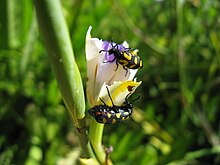You are here
Taxonomy
Meloidae
EOL Text
http://entnemdept.ufl.edu/creatures/urban/medical/blister_beetles.htm
Founded in 1996 by Thomas Fasulo, Featured Creatures provides in-depth profiles of insects, nematodes, arachnids and other organisms.
The Featured Creatures site is a cooperative venture of the University of Florida's Entomology and Nematology Department and the Florida Department of Agriculture and Consumer Services' Division of Plant Industry.
Visit Featured Creatures at http://entnemdept.ifas.ufl.edu/creatures/
| License | http://creativecommons.org/licenses/by-nc-sa/3.0/ |
| Rights holder/Author | Featured Creatures |
| Source | http://entnemdept.ufl.edu/creatures/urban/medical/blister_beetles.htm |
| This article needs additional citations for verification. Please help improve this article by adding citations to reliable sources. Unsourced material may be challenged and removed. (November 2013) |
Blister beetles are beetles (Coleoptera) of the family Meloidae, so called for their defensive secretion of a blistering agent, cantharidin. About 7,500 species are known worldwide. Many are conspicuous and some are aposematically colored, announcing their toxicity to would-be predators.
Contents
Description[edit]
Cantharidin is a poisonous chemical that causes blistering of the skin.It is used medically to remove warts[1] and is collected for this purpose from species of the genera Mylabris and Lytta, especially Lytta vesicatoria, better known as "Spanish fly".
Blister beetles are hypermetamorphic, going through several larval stages, the first of which is typically a mobile triungulin. The larvae are insectivorous, mainly attacking bees, though a few feed on grasshopper eggs; while sometimes considered parasitoids, in general, the meloid larva apparently consumes the immature host along with its provisions, and can often survive on the provisions alone, thus it is not an obligatory parasitoid, but rather a facultative parasitoid, or simply predatory. The adults sometimes feed on flowers and leaves of plants of such diverse families as Amaranthaceae, Asteraceae, Fabaceae, and Solanaceae.
Toxicity[edit]
Cantharidin is the principal irritant in "Spanish fly", a folk medicine prepared from dried beetles in the Meloidae family.
The largest genus, Epicauta, contains many species toxic to horses. A few beetles consumed in a single feeding of alfalfa hay may be lethal.[2] In semiarid areas of the western United States, modern harvesting techniques may contribute to cantharidin content in harvested forage. The practice of hay conditioning, crushing the stalks to promote drying, also crushes any beetles present and causes the release of cantharidin into the fodder. Blister beetles are attracted to alfalfa and weeds during bloom. Reducing weeds and timing harvests before and after bloom are sound management practices. Using equipment without hay conditioners may reduce beetle mortality and allow them to escape before baling.[3]
Systematics[edit]
Subfamily Eleticinae[edit]
Tribe Derideini
Tribe Morphozonitini
Tribe Eleticini
Tribe Spasticini
Subfamily Meloinae[edit]
Tribe Cerocomini
Tribe Epicautini
Tribe Eupomphini

Blister beetles like this Lytta vesicatoria (Meloinae: Lyttini) can be safely handled, provided the animal is not startled, and allowed to move around freely. Otherwise, painful poisonings may occur.
Tribe Lyttini
- Acrolytta
- Afrolytta
- Alosimus
- Berberomeloe
- Cabalia
- Dictyolytta
- Eolydus
- Epispasta
- Lagorina
- Lydomorphus
- Lydulus
- Lydus
- Lytta
- Lyttolydulus
- Lyttonyx
- Megalytta
- Muzimes
- Oenas
- Parameloe
- Paroenas
- Physomeloe
- Prionotolytta
- Prolytta
- Pseudosybaris
- Sybaris
- Teratolytta
- Tetraolytta
- Trichomeloe
Tribe Meloini
Tribe Mylabrini
- Ceroctis
- Croscherichia
- Hycleus
- Lydoceras
- Mimesthes
- Mylabris
- Paractenodia
- Pseudabris
- Semenovilia
- Xanthabris
Tribe Pyrotini
- Bokermannia
- Brasiliota
- Denierota
- Glaphyrolytta
- Lyttamorpha
- Picnoseus
- Pseudopyrota
- Pyrota
- Wagneronota
Genera incertae sedis
Subfamily Nemognathinae[edit]
Tribe Horiini
Tribe Nemognathini
- Cochliophorus
- Euzonitis
- Gnathium
- Gnathonemula
- Leptopalpus
- Megatrachelus
- Nemognatha
- Palaestra
- Palaestrida
- Pseudozonitis
- Rhyphonemognatha
- Stenodera
- Zonitis
- Zonitodema
- Zonitolytta
- Zonitomorpha
- Zonitoschema
Tribe Sitarini
Genera incertae sedis
Subfamily Tetraonycinae[edit]
Tribe Tetraonycini
See also[edit]
References[edit]
- ^ Bhattacharjee, Pradip; Brodell, Robert T. (2003). "Cantharidin". In Robert T. Brodell and Sandra Marchese Johnson, eds. Warts: Diagnosis and Management—an Evidence-Based Approach. London: Martin Dunitz. pp. 151–160. ISBN 1-84184-240-0.
- ^ University of Arizona VDL Blister Beetle Poisoning in Horses
- ^ University of Colorado Extension Blister Beetles in Forage Crops
| License | http://creativecommons.org/licenses/by-sa/3.0/ |
| Rights holder/Author | Wikipedia |
| Source | http://en.wikipedia.org/w/index.php?title=Blister_beetle&oldid=654522888 |
With their slow movements, distended abdomens and their propensity for grass, oil beetles will forgive me for thinking that they are the insect equivalent of cows...
| License | http://creativecommons.org/publicdomain/mark/1.0/ |
| Rights holder/Author | Katja Schulz, Katja Schulz |
| Source | http://bugs.adrianthysse.com/2012/08/the-black-oil-beetle/ |
Oil beetles are capable of synthesizing cantharidin, one of the most poisonous compounds known to man.
| License | http://creativecommons.org/publicdomain/mark/1.0/ |
| Rights holder/Author | Katja Schulz, Katja Schulz |
| Source | http://thesmallermajority.com/2012/10/08/life-saving-beetles/ |
Meloidae (Blister Beetles)
These beetles are medium to medium-large in size. They are fairly long, with rectangular wing-cases, and heads that are wider than the pronotum. They are black, brown, tan, or red, with variable patterns. When disturbed, Blister Beetles exude blood with an irritating chemical that can cause blisters. Adults are often serious pests that feed on foliage and flowers, as well as pollen and nectar. The larvae are usually beneficial, feeding underground on grasshopper egg cases and the immature specimens of other insects. A typical example is Epicauta pensylvanica (Black Blister Beetle), which sometimes appears in large numbers on goldenrod and other flowers.
| License | http://creativecommons.org/licenses/by-nc/3.0/ |
| Rights holder/Author | Copyright © 2002-2015 by Dr. John Hilty |
| Source | http://www.illinoiswildflowers.info/flower_insects/files/beetles.htm |
Barcode of Life Data Systems (BOLD) Stats
Specimen Records:588
Specimens with Sequences:496
Specimens with Barcodes:437
Species:74
Species With Barcodes:61
Public Records:45
Public Species:21
Public BINs:25
Collection Sites: world map showing specimen collection locations for Meloidae![]()







